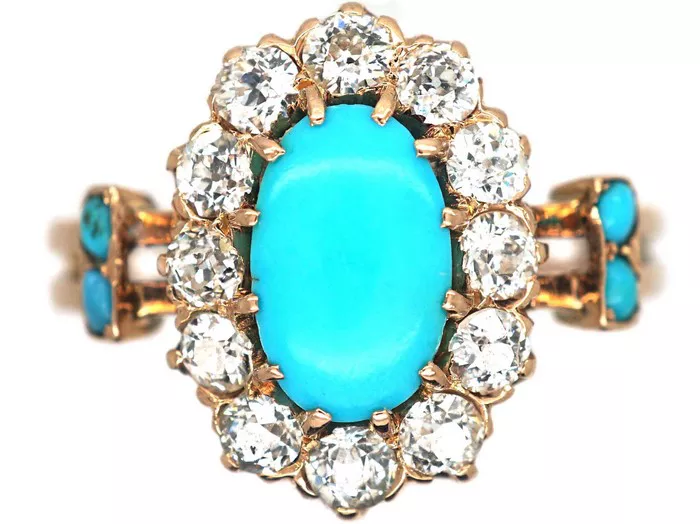Turquoise has captivated civilizations for millennia with its vibrant blue-green hues and unique veining patterns. As one of the world’s oldest gemstones, its allure extends beyond aesthetics to cultural significance and metaphysical beliefs. However, the market is flooded with imitations and synthetics, making it challenging to discern authentic turquoise from its counterparts. Whether you’re a gemstone enthusiast, jewelry collector, or simply seeking genuine turquoise for its beauty and metaphysical properties, understanding how to identify real turquoise is essential.
Understanding Turquoise: Origins, Composition, and Characteristics
Before delving into identification techniques, it’s crucial to grasp what turquoise is and its distinguishing features. Turquoise is a hydrous phosphate mineral primarily composed of copper and aluminum, with traces of iron contributing to its blue-green coloration. Its formation occurs through the percolation of copper-rich solutions into porous rocks, often resulting in intricate veining known as “matrix.” This matrix, comprised of host rock materials like limonite or sandstone, serves as a distinguishing characteristic of genuine turquoise.
Examine Color and Hue
One of the most recognizable traits of turquoise is its distinctive color. Genuine turquoise exhibits a range of hues from sky blue to greenish-blue, with variations influenced by factors such as copper content and the presence of impurities. Avoid specimens that appear overly vibrant or uniform in color, as natural turquoise typically displays subtle variations and mottling due to its mineral composition and formation process.
Assess Matrix and Veining Patterns
The presence of matrix and veining is a hallmark feature of authentic turquoise. These intricate patterns, formed by the surrounding host rock, lend character and uniqueness to each specimen. Genuine turquoise often showcases matrix in varying shades of brown, black, or golden brown, intricately interwoven with the blue-green base color. Examine the matrix closely for irregularities and natural formations, as synthetic imitations often lack the nuanced detail found in natural turquoise.
Evaluate Hardness and Texture
Turquoise possesses a moderate hardness ranging from 5 to 6 on the Mohs scale, making it relatively durable for jewelry and ornamental purposes. When assessing a specimen, gently run your finger along its surface to gauge its texture. Genuine turquoise typically feels smooth yet slightly porous, with a matte or waxy finish. Beware of materials that feel excessively smooth or plastic-like, as they may indicate synthetic substitutes or treated stones.
Conduct a Density Test
Density can provide valuable insight into a gemstone’s authenticity, as natural minerals often have characteristic density values. To perform a density test on turquoise, submerge the specimen in a container of water and observe its buoyancy. Genuine turquoise tends to have a density ranging from 2.60 to 2.90 g/cm³, depending on its composition and porosity. If the stone floats or sinks rapidly, it may indicate a synthetic or treated material masquerading as turquoise.
Perform a Scratch Test
While not definitive, a scratch test can help distinguish between genuine turquoise and softer imitations. Using a sharp object such as a pocket knife or nail, carefully attempt to scratch the surface of the stone in an inconspicuous area. Authentic turquoise should resist scratching or show minimal signs of abrasion due to its moderate hardness. Be cautious when performing this test, as excessively scratching valuable specimens can diminish their aesthetic and monetary value.
Seek Professional Authentication
When in doubt, seek the expertise of a certified gemologist or reputable jeweler for professional authentication. Gemological laboratories equipped with advanced testing instruments can provide accurate assessments of turquoise authenticity using techniques such as spectroscopy, X-ray diffraction, and microscopy. While this option may incur additional costs, it offers peace of mind and assurance when purchasing valuable turquoise specimens or jewelry.
Beware of Common Misconceptions
In the quest to identify real turquoise, it’s essential to debunk common misconceptions and myths surrounding the gemstone. One prevalent misconception is that all turquoise undergoes stabilization or treatment to enhance its color and durability. While stabilization is common practice in the gemstone industry, particularly for enhancing stability and preventing discoloration, it does not necessarily compromise the authenticity of turquoise. Additionally, the absence of matrix or veining does not automatically indicate synthetic turquoise, as some high-quality specimens may exhibit a homogeneous appearance.
Conclusion
Identifying real turquoise requires a keen eye, attention to detail, and familiarity with the gemstone’s characteristics. By examining factors such as color, matrix, hardness, density, and seeking professional authentication when necessary, enthusiasts can confidently differentiate between genuine turquoise and its imitations. Remember to approach each specimen with curiosity and respect for its geological origins, cultural significance, and enduring beauty. Whether adorning jewelry, adorning art, or serving as a cherished talisman, authentic turquoise continues to captivate hearts and minds across the globe.
FAQs
What are some common imitations of turquoise?
Common imitations of turquoise include dyed magnesite, dyed howlite, and synthetic materials such as reconstituted turquoise and turquoise-colored glass. These materials may resemble turquoise in appearance but lack its characteristic properties and composition.
Does all turquoise have matrix and veining?
While matrix and veining are common features of natural turquoise, not all specimens exhibit these characteristics. Some high-quality turquoise may appear homogeneous without prominent matrix or veining. Conversely, the absence of matrix does not necessarily indicate synthetic turquoise.
How does stabilization affect the authenticity of turquoise?
Stabilization is a common treatment used to enhance the color and durability of turquoise. While stabilized turquoise may undergo treatment processes to improve its appearance and stability, it is still considered authentic if it retains its natural composition and characteristics.
Is it safe to perform a scratch test on turquoise?
While a scratch test can provide some insight into a gemstone’s hardness, it should be conducted with caution to avoid damaging valuable specimens. Use a sharp object in an inconspicuous area and apply minimal pressure to assess the stone’s resistance to scratching.

